Electricity Consumption and Operational Carbon Emissions of European Telecom Network Operators
Abstract
:1. Introduction
2. Materials and Methods
3. Results
3.1. Electricity Consumption and Related Carbon Emissions of ETNO Operators
3.2. Electricity Consumption Per Network Type
3.3. Electricity Consumption Per Subscription
- (i)
- Energy consumption related to offices, stores, etc.: 60% mobile, 30% fixed broadband, and 10% PSTN.
- (ii)
- Data network operations: 55% fixed broadband, 35% mobile, and 10% PSTN. Half of the overhead electricity consumption is related to onsite installations and is divided equally between the three network types, and the remaining half is related to the data traffic, which is shared between mobile and fixed broadbands.
- (iii)
- Operators’ data center operations: 55% mobile and 45% fixed broadband. The allocation is based on the conditions of the data set. However, there are great variations between the operators. As in Section 3.1 and Section 3.2, the electricity supply chain and distribution losses are not included.
3.4. Operational Carbon Emissions from Other Sources Than Electricity Consumption
3.5. Validation of ETNO Data Set against the Operators’ Publicly Reported Values
3.6. The Extended Trend Line—2010–2018 Development
3.7. Electricity Consumption in Relation to Data Traffic of 2010–2018
3.8. Electricity Consumption and Operational Carbon Emissions for ETNO Europe 2020
- Total subscriptions increased 9% (369 million in 2018 to 401 million subscriptions in 2020)
- Electricity consumption decreased 1% (from 14.5 TWh in 2018 to 14.3 TWh in 2020)
- Renewable electricity increased 18% (from 10.3 TWh in 2018 to 12.2 TWh in 2020)
- Share of renewable electricity increased (from 71% in 2018 to 85% in 2020)
3.9. Electricity Consumption and Related Carbon Emissions Estimated for Telecom Network Operators in Europe-30 for 2018
3.10. Electricity Consumption Data for 2020 in Europe-30, including Additional Operators
- There were 23.4-TWh electricity and 687 million subscriptions resulting in an average electricity consumption per subscription of 34 kWh/subscription. This is lower than the corresponding value for ETNO operators for Europe (36 kWh/subscription). This difference is partly due to a lower share of PSTN and core networks and lower overhead operations (operators’ data centers, offices, stores, etc.) among the additional operators.
- In total, 15 TWh of purchased renewable electricity was identified. However, data gaps exist for several operators.
- If scaled by subscriptions to the entire Europe-30, the resulting total electricity consumption is estimated to be about 35 TWh for 2020, covering about 1034 million subscriptions [15,16,17]. For EU-27, the resulting total electricity consumption is estimated to be about 29 TWh for 2020, covering about 865 million subscriptions [15,16,17].
4. Discussion
4.1. General Comments on the Results
4.2. Data Quality
4.3. Uncertainties
4.4. Applicability of Results for Other Regions
4.5. Applicability of Results as a Basis for Estimates of the Future
4.6. Alignment with Standards
4.7. Future Work and the Importance of Collecting Up-To-Date Data from Real Networks
5. Conclusions
- The electricity consumption and number of subscriptions for the reporting telecom network operators (ETNO Total) remained nearly constant (+1 percent and -3 percent, respectively) between 2015 and 2018, while the data traffic increased by a factor 3.
- During the period, the share of renewable electricity increased to 71%, which has led to a decrease in carbon emissions. For 2018, the operational carbon intensity of the operators equaled 6.6-kg CO2 eq per subscription (excluding embodied emissions).
- The intensities were quite constant for 2015–2018. For 2018, the electricity intensity per subscription (including overhead) was 62 kWh/subscription for fixed networks and 17 kWh/subscription for mobile networks, leading to a total average of 26 kWh/subscription.
- For the extended period of 2010–2018, the electricity consumption per subscription (ETNO Total, including overhead) remained quite stable and slightly below 30 kWh/subscription despite substantial data traffic growth (by a factor 12).
- For Europe, the intensity for the reporting telecom network operators (ETNO Europe) was 39 kWh/subscription for 2018, representing a slight increase over the period. Based on public reporting by ETNO Operators for 2020, the intensity then reduced slightly (36 kWh/subscription), which could be compared to 34 kWh/subscription for the extended data set covering ETNO Europe and additional operators.
- The overall electricity usage and operational carbon emissions of telecom operators are estimated as 38 TWh and 14 Mton CO2 eq for the EU (then including the UK) for 2018, and for 2020, the electricity consumption is estimated as 29 TWh for EU-27 (excluding the UK).
Supplementary Materials
Author Contributions
Funding
Institutional Review Board Statement
Informed Consent Statement
Data Availability Statement
Acknowledgments
Conflicts of Interest
References
- Malmodin, J.; Lundén, D. The Energy and Carbon Footprint of the Global ICT and E&M Sectors 2010–2015. Sustainability 2018, 10, 3027. [Google Scholar]
- Andrae, A.S.G. Hypotheses for primary energy use, electricity use and CO2 emissions of global computing and its shares of the total between 2020 and 2030. WSEAS Trans. Power Syst. 2020, 15, 50–59. [Google Scholar] [CrossRef]
- GeSI. Digital with Purpose: Delivering a SMARTer2030; GeSI: Brussels, Belgium, 2019; Available online: https://gesi.org/storage/files/DIGITAL%20WITH%20PURPOSE_Summary_A4-WEB_watermark.pdf (accessed on 21 December 2021).
- ITU. Recommendation L.1470 (01/20), L.1470: Greenhouse Gas Emissions Trajectories for the Information and Communication Technology Sector Compatible with the UNFCCC Paris Agreement, (Appendix IV); International Telecommunication Union: Geneva, Switzerland, 2020. [Google Scholar]
- VHK and Viegand Maagoe. ICT Impact Study, Final Report, for the European Commission. 2020. Available online: https://susproc.jrc.ec.europa.eu/product-bureau/sites/default/files/2020-11/IA_report-ICT_study_final_2020_(CIRCABC).pdf (accessed on 14 February 2022).
- OECD/IEA. Digitalization & Energy, International Energy Agency. 2017. Available online: https://iea.blob.core.windows.net/assets/b1e6600c-4e40-4d9c-809d-1d1724c763d5/DigitalizationandEnergy3.pdf (accessed on 14 February 2022).
- 4E TCP. Intelligent Efficiency for Data Centres & Wide Areas Networks, Electronic Devices & Networks Annex (EDNA). 2019. Available online: https://www.iea-4e.org/wp-content/uploads/publications/2019/05/A1b_-_DC_WAN_V1.0.pdf (accessed on 14 February 2022).
- Bieser, J.; Salieri, B.; Hischier, R.; Hilty, L.M. Next Generation Mobile Networks, Problem or Opportunity for Climate Protection? EMPA, University of Zurich and Swisscom Report; Zurich: St. Gallen, Switzerland, 2020; Available online: https://plus.empa.ch/images/5G%20climate%20protection_University%20of%20Zurich_Empa.pdf (accessed on 21 December 2021).
- Van Heddeghem, W.; Lambert, S.; Lannoo, B.; Colle, D.; Pickavet, M.; Demeester, P. Trends in worldwide ICT electricity consumption from 2007 to 2012. Comput. Commun. 2014, 50, 64–76. [Google Scholar] [CrossRef] [Green Version]
- Malmodin, J.; Lundén, D. The Electricity Consumption and Operational Carbon Emissions of ICT Network Operators 2010–2015; KTH: Stockholm, Sweden, 2018; p. 13. [Google Scholar]
- ITU. Recommendation L.1410 (12/14), L.1410: Methodology for Environmental Life Cycle Assessments Of Information and Communication Technology Goods, Networks And Services; International Telecommunication Union: Geneva, Switzerland, 2014. [Google Scholar]
- Auer, G.; Gódor, I.; Hévizi, L.; Imran, M.A.; Malmodin, J.; Fazekas, P.; Biczók, G.; Holtkamp, H.; Zeller, D.; Blume, O.; et al. Enablers for energy efficient wireless networks. In Proceedings of the 2010 IEEE 72nd Vehicular Technology Conference-Fall, Ottawa, ON, Canada, 6–9 September 2010; pp. 1–5. [Google Scholar]
- World Resource Institute. Greenhouse Gas Protocol, A Corporate Accounting and Reporting Standard, Revised; World Business Council for Sustainable Development ad World Resources Institute: Washington, DC, USA, 2004; Available online: https://ghgprotocol.org/sites/default/files/standards/ghg-protocol-revised.pdf (accessed on 17 December 2021).
- ITU. Key ICT Indictors for Developed and Developing Countries, the World and Special Regions (Totals and Penetration Rates) Excel File from Nov 2020. Available online: https://www.itu.int/en/ITU-D/Statistics/Documents/facts/ITU_regional_global_Key_ICT_indicator_aggregates_Nov_2020.xlsx (accessed on 25 September 2021).
- ITU. ICT Data (Latest Available Data) for Fixed-Telephone Subscriptions (Excel). Available online: https://www.itu.int/en/ITU-D/Statistics/Documents/statistics/2021/July/FixedTelephoneSubscriptions_2000-2020.xlsx (accessed on 25 September 2021).
- ITU. Fixed-broadband Subscriptions (Excel). Available online: https://www.itu.int/en/ITU-D/Statistics/Documents/statistics/2021/July/FixedBroadbandSubscriptions_2000-2020.xlsx (accessed on 25 September 2021).
- ITU. Mobile-Cellular Subscriptions (Excel). Available online: https://www.itu.int/en/ITU-D/Statistics/Documents/statistics/2021/July/MobileCellularSubscriptions_2000-2020.xlsx (accessed on 25 September 2021).
- World Resource Institute. Greenhouse Gas Protocol Scope 2 Guidance—Executive Summary, an Amendment to the GHG Protocol Corporate Standard. 2015. Available online: https://ghgprotocol.org/sites/default/files/Scope2_ExecSum_Final.pdf (accessed on 10 December 2021).
- Altice. Sustainability Report Altice Portugal 2019; Altice: Lisboa, Portugal, 2020; Available online: https://conteudos.telecom.pt/Documents/EN/sustainability/Sustainability-report-2019.pdf (accessed on 13 December 2021).
- Budde Com. Portugal Telecoms Market Report, Telecoms, Mobile and Broadband—Statistics and Analyses, Updated 2 Nov 2021. Available online: https://www.budde.com.au/Research/Portugal-Telecoms-Mobile-and-Broadband-Statistics-and-Analyses (accessed on 22 December 2021).
- BT. BT Group plc—Digital Impact and Sustainability Report 2021; BT: London, UK, 2021; Available online: https://www.bt.com/bt-plc/assets/documents/digital-impact-and-sustainability/our-report/report-archive/2021/bt-dis-report.pdf (accessed on 13 December 2021).
- BT. BT Group plc—Digital Impact and Sustainability Report 2020/2021—Environmental Data. Updated 9 June 2021. Available online: https://www.bt.com/bt-plc/assets/documents/digital-impact-and-sustainability/our-report/report-archive/2021/2021-bt-environmental-data-and-emissions.xlsx (accessed on 13 December 2021).
- Openreach. UK Broadband Usage More Than Doubled in 2020—Driven by Live Sport, Online Gaming and Home Working. 29 December 2020. Available online: https://www.openreach.com/news/uk-broadband-usage-more-than-doubled-in-2020---driven-by-live-sport-online-gaming-and-home-working/ (accessed on 22 December 2021).
- OTE. 2020 Appendix; OTE: Athens, Greece, 2020; Available online: https://www.cosmote.gr/otegroup_company/sustainability/reports/ote/eng/appendix_eng2020.pdf (accessed on 13 December 2021).
- OTE. Sustainability Report 2018; OTE: Athens, Greece, 2018; Available online: https://www.cosmote.gr/otegroup_company/sustainability/reports/ote/eng/2018.pdf (accessed on 13 December 2021).
- DNA. DNA 2018 Annual Report; DNA: Helsinki, Finland, 2018; Available online: https://corporate.dna.fi/documents/94506/491939/DNA_annual_report_2018.pdf (accessed on 13 December 2021).
- DT. Corporate Responsibility Report 2020. In Corporate Responsibility Report 2020; Deutsche Telekom AG: Bonn, Germany, 2020; Available online: https://www.cr-report.telekom.com/site21/sites/default/files/pdf/cr_en_2020_dt_final.pdf (accessed on 13 December 2021).
- Elisa. Responsibility 2020, Elisa Annual Report 2020. Available online: https://static.elisa.com/v2/image/2tqybbhjs47b/4zwayOcLhlPoe9eqRKl84W/Elisa_Responsibility_report_2020.pdf (accessed on 13 December 2021).
- KPN. KPN Integrated Annual Report 2020—Accelerating Digitalization of the Netherlands; KPN: Rotterdam, the Netherlands, 2020; Available online: https://www.jaarverslag2020.kpn/downloads/Integrated-Annual-Report-2020-Spread-navigation.pdf (accessed on 13 December 2021).
- Proximus. Integrated Annual Report 2020 Proximus Group. In Integrated Annual Report 2020 Proximus Group; Proximus Group: Brussels, Belgium; Available online: https://www.proximus.com/dam/jcr:45b19e25-4f3a-44bb-8608-b6af8daeaa7f/12-Integrated-Annual-Report-2020_en.pdf (accessed on 13 December 2021).
- Swisscom. Sustainability Report 2020—We Are Ready. Available online: https://reports.swisscom.ch/download/2020/en/swisscom_nachhaltigkeitsbericht_gesamt_2020_en.pdf (accessed on 13 December 2021).
- Telecom Italia. 2020 Sustainability Report—Consolidated Non-Financial Statement 2020 Pursuant to D.Lgs.254/2016; Telecom Italia: Milan, Italy, 2020; Available online: https://www.gruppotim.it/content/dam/gt/sostenibilit%C3%A0/doc-bilanci/TIM-Sustainability-Report-2020.pdf (accessed on 13 December 2021).
- Telefonica. Telefonica Consolidated Management Report 2018 Towards a Sustainable and Long Term Company. Available online: https://www.telefonica.com/en/wp-content/uploads/sites/5/2021/03/Telefonica-Integrated-Management-Report-2018.pdf (accessed on 13 December 2021).
- Telefonica 2021. Consolidated Management Report 2020. Available online: https://www.telefonica.com/documents/153952/13347920/2020-Telefonica-Consolidated-Management-Report.pdf (accessed on 13 December 2021).
- Telenor. Telenor Group Sustainability Analytical Tool 2020. Available online: https://www.telenor.com/wp-content/uploads/2021/04/Telenor-Group-Sustainability-Performance-Analytical-tool-2020.xlsx (accessed on 13 December 2021).
- Telia Company. Better Connected Living—Annual Sustainability Report 2020; Telia Company: Stockholm, Sweden, 2020; Available online: https://www.teliacompany.com/globalassets/telia-company/documents/reports/2020/annual/telia-company--annual-and-sustainability-report-2020.pdf (accessed on 13 December 2021).
- Altice. Altice International On-Financial Performance Statements 2020. Altice: Luxembourg; Available online: https://altice.net/sites/default/files/pdf/Altice%20International%20Non-Financial%20Performance%20Statement%202020.pdf (accessed on 13 December 2021).
- Altice. Altice International Full Year & Q4 2020 Results. 2021. Available online: https://altice.net/sites/default/files/pdf/Altice%20International%20Q4%20%26%20FY%202020%20Press%20Release.pdf (accessed on 13 December 2021).
- BT. Consumer. Available online: https://www.bt.com/about/bt/our-company/group-businesses/consumer (accessed on 13 December 2021).
- OTE. 2020 Integrated Report; OTE: Athens, Greece, 2020; Available online: https://www.cosmote.gr/otegroup_company/sustainability/reports/ote/eng/2020.pdf (accessed on 13 December 2021).
- OTE. Annual Report. Available online: https://www.cosmote.gr/otegroup_company/annualreport/2020/en/ (accessed on 13 December 2021).
- Telenor Group Annual Report 2020; Telenor: Fornebu, Norway, 2020; Available online: https://www.telenor.com/wp-content/uploads/2021/03/TelenorAnnualReport2020ENG.pdf (accessed on 13 December 2021).
- DT. Deutsche Telekom Company Presentation 2021. Available online: https://www.telekom.com/resource/blob/326540/b571be909e91b60386cb3126b2578c2b/dl-presentation-deutsche-telekom-data.pdf (accessed on 13 December 2021).
- Swisscom. Annual Report 2020. Available online: https://reports.swisscom.ch/download/2020/en/swisscom_geschaeftsbericht_gesamt_2020_en.pdf (accessed on 13 December 2021).
- TIM. Profile, Key Numbers at 30 September 2021. Available online: https://www.gruppotim.it/en/group/about-us/tim-group-profile.html (accessed on 13 December 2021).
- Telecom Slovenia 2021. Annual Report for 2020, Telekom Slovenije Group and Telekom Slovenije, #Connected in the first network in Slovenia, April 2021, Ljubljana, Slovenia. Available online: https://www.telekom.si/Documents/Annual-report-2020.pdf (accessed on 13 December 2021).
- ITU. Recommendation L.1450 (09/18), L.1450: Methodologies for the Assessment of the Environmental Impact of the Information and Communication Technology Sector; International Telecommunication Union: Geneva, Switzerland, 2018. [Google Scholar]
- EEA. Greenhouse Gas Emission Intensity of Electricity Generation in Europe, European Environment Agency. 2021. Available online: https://www.eea.europa.eu/data-and-maps/daviz/co2-emission-intensity-9/download.table (accessed on 17 December 2021).
- Statista. Vodafone: Quarterly 4G Mobile Data Usage in Europe from 4th Quarter 2013/14 to 4th Quarter 2020/21 in Petabytes. Available online: https://www.statista.com/statistics/630188/vodafone-quarterly-4g-mobile-data-usage-in-europe/ (accessed on 22 December 2021).
- Orange. 2020 Integrated Annual Report; Orange: Issy-les-Moulineaux, France, 2020; Available online: https://rai2020.orange.com/wp-content/uploads/sites/44/2021/07/orange_integratedannualreport_2020_en_2.pdf (accessed on 13 December 2021).
- Cyfrowy Polstat. Corporate Social Responsibility Report of Polstat Group 2020; Cyfrowy Polstat: Warsaw, Poland, 2021; Available online: https://grupapolsatplus.pl/sites/default/files/documents/2021/social_responsibility_report_of_polsat_group_for2020.pdf (accessed on 13 December 2021).
- Vodafone Group. Vodafone Group CDP Climate Change Questionnaire 2020. Available online: https://www.vodafone.com/sites/default/files/2021-08/vodafone-group-cdp-questionnaire-2020.pdf (accessed on 13 December 2021).
- Windtre. 2020 Sustainability Report 2030 ESG Goals for a More Sustainable Future. Available online: https://www.windtregroup.it/Documenti_Sustainability/Report/ENG/WINDTRE/sustainability%20report_2020.pdf (accessed on 13 December 2021).
- CK Hutchinson Holdings Limited. 2020 Interim Report. Available online: https://doc.irasia.com/listco/hk/ckh/interim/2020/intrep.pdf (accessed on 14 January 2022).
- Ericsson. Breaking the Energy Curve—An Innovative Approach to Reducing Mobile Network Energy Use; Ericsson: Stockholm, Sweden, 2020; Available online: https://www.ericsson.com/495d5c/assets/local/about-ericsson/sustainability-and-corporate-responsibility/documents/2020/breaking-the-energy-curve-report.pdf (accessed on 25 November 2021).
- Nokia. 5G Network Energy Efficiency—Massive Capacity Boost with Plat Energy Consumption, White Paper; Nokia: Espoo, Finland, 2016; Available online: https://onestore.nokia.com/asset/200876 (accessed on 25 November 2021).
- GSMA. Comparison of Fixed and Mobile Cost Structures; GSMA: London, UK, 2012; Available online: https://www.gsma.com/publicpolicy/wp-content/uploads/2012/09/Tax-Comparison-of-fixed-and-mobile-cost-structures.pdf (accessed on 25 November 2021).
- ETNO. State of Digital Communications 2022. European Telecommunications Network Operators’ Association. 2022. Available online: https://etno.eu/library/reports/104-state-of-digi-2022.html (accessed on 16 February 2022).
- GSMA. COVID-19 Network Traffic Surge Isn’t Impacting Environment Confirm Telecom Operators. 2020. Available online: https://www.gsma.com/gsmaeurope/latest-news-2/covid-19-network-traffic-surge-isnt-impacting-environment-confirm-telecom-operators/ (accessed on 15 October 2020).
- GSMA. Energy Efficiency: An Overview. Available online: https://www.gsma.com/futurenetworks/wiki/energy-efficiency-2/ (accessed on 25 March 2021).

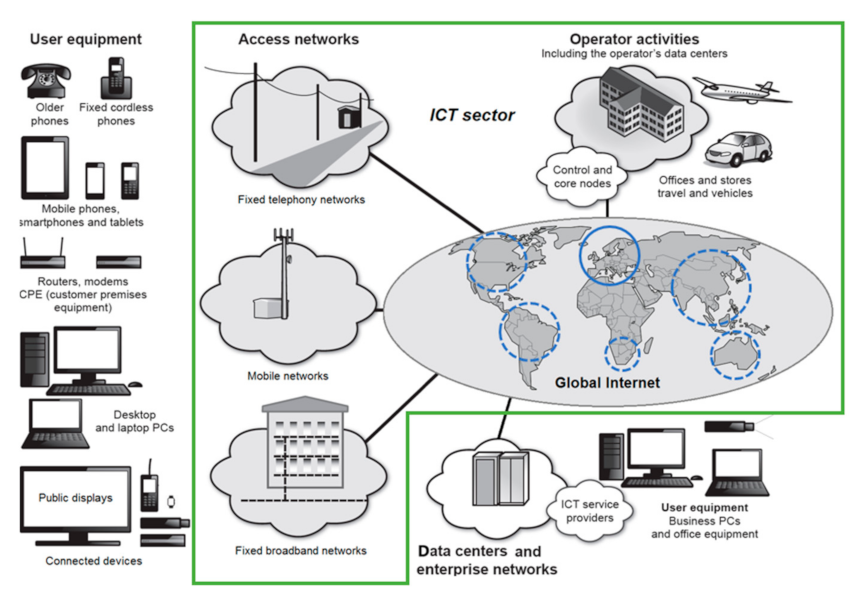
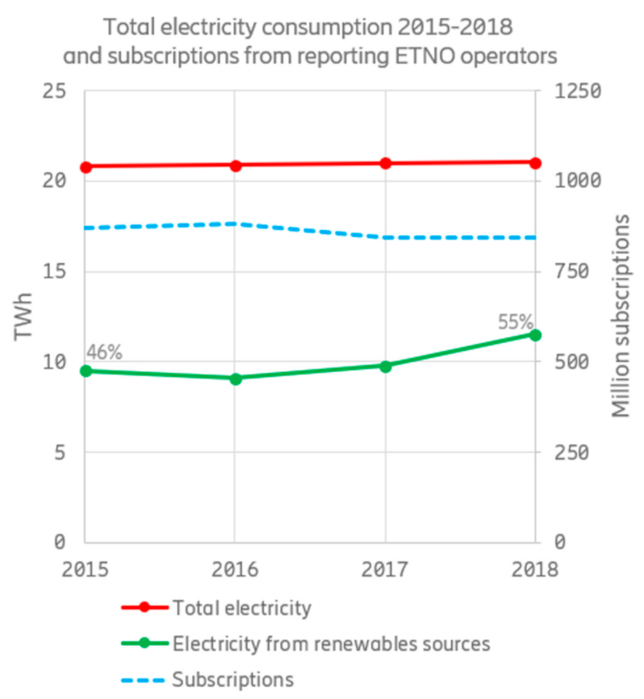
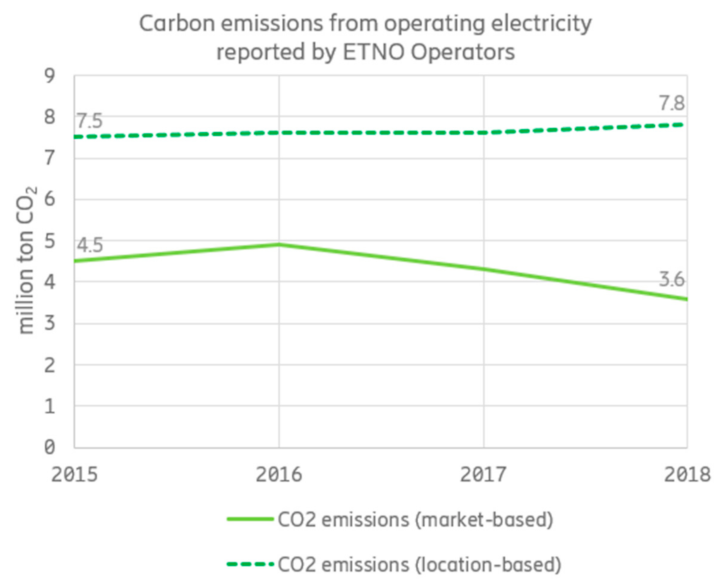
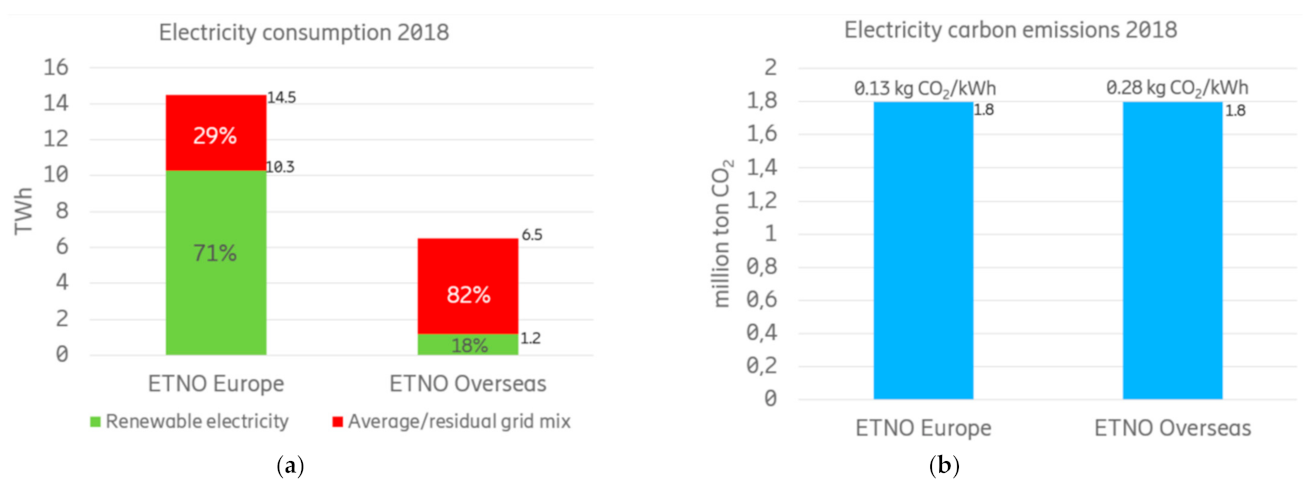
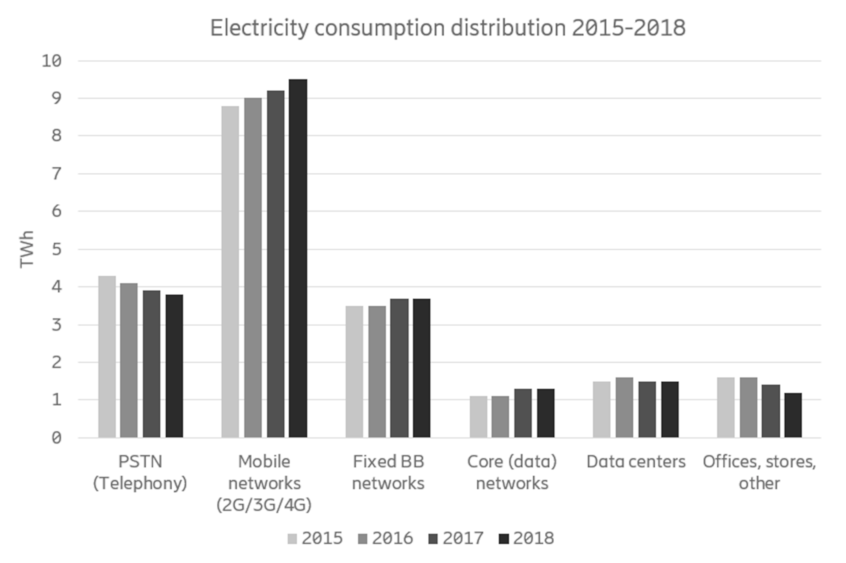
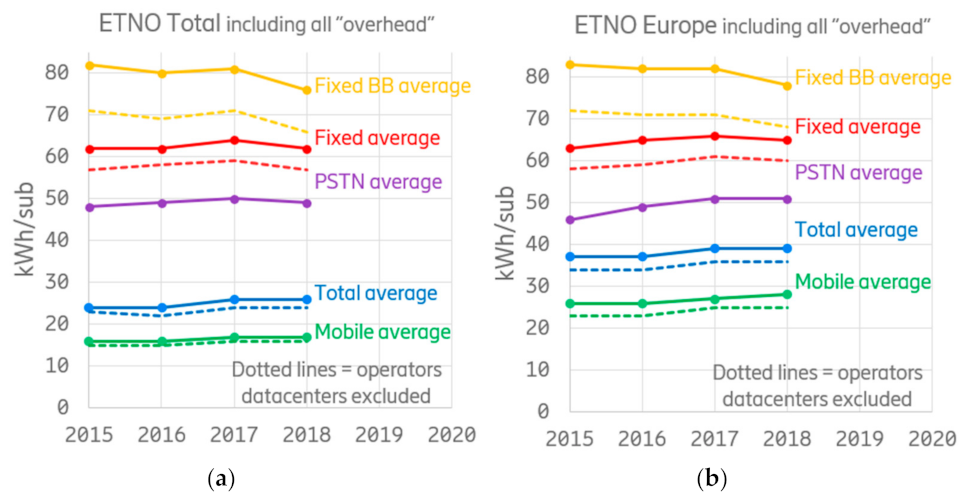
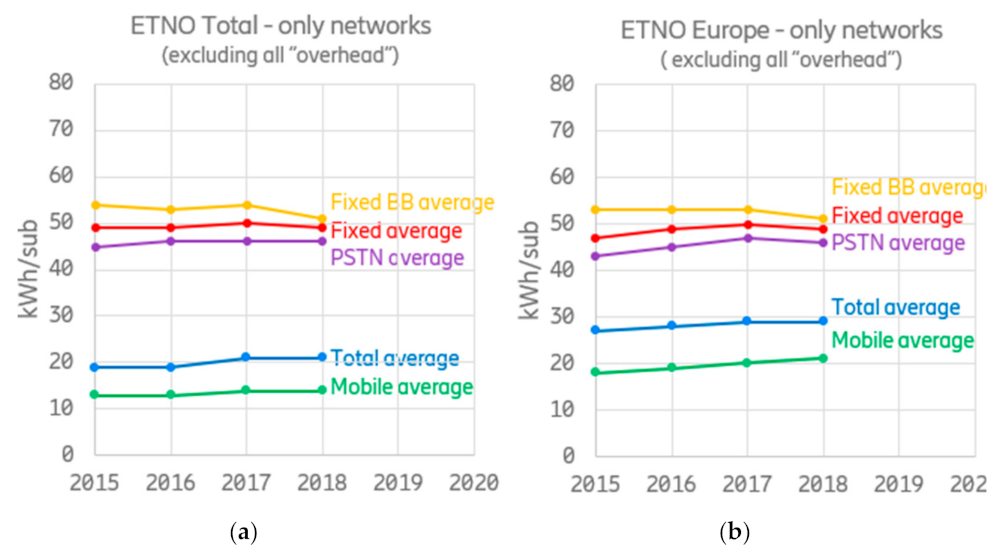
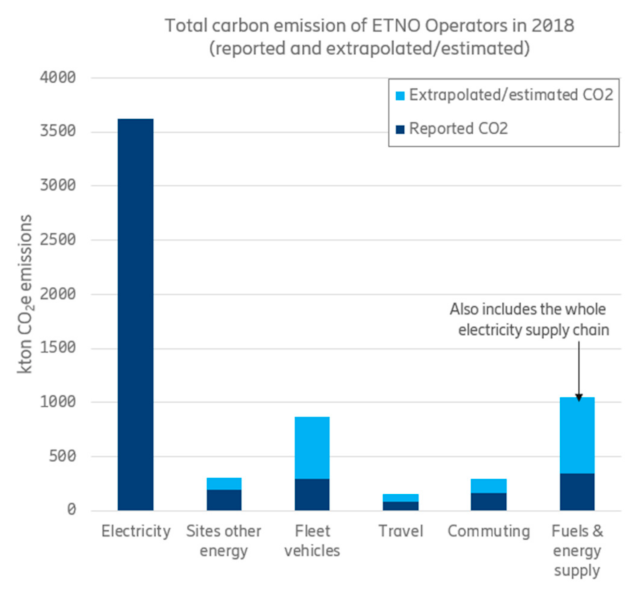
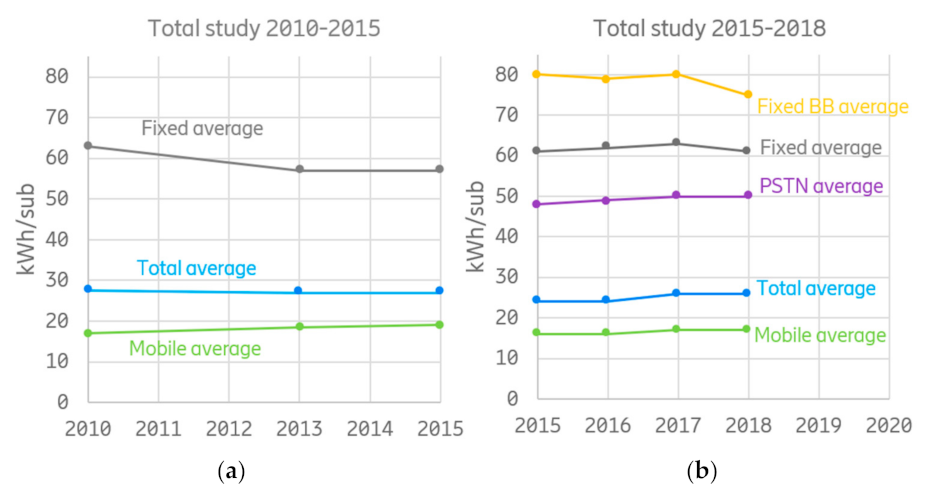

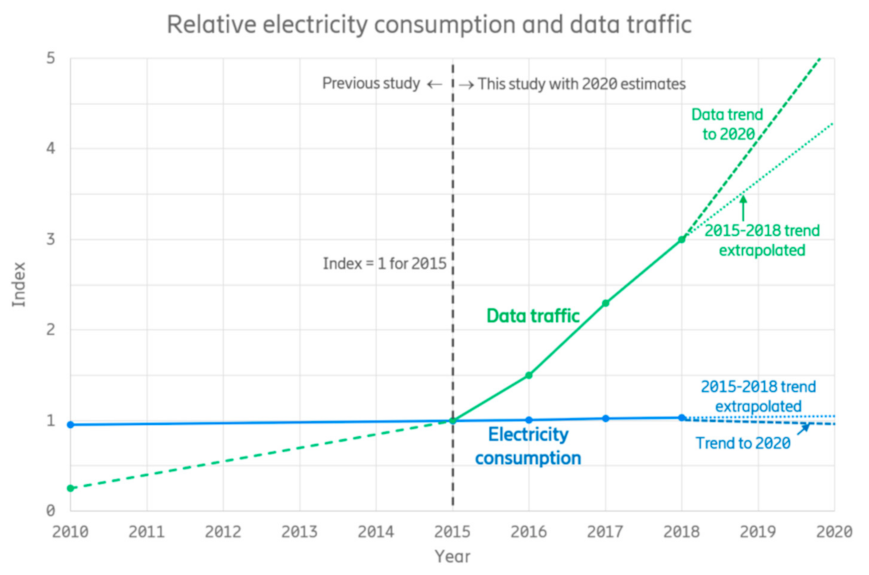
| Included Network Types: |
| Fixed telephony access networks (aka PSTN 1/POTS 1) |
| Fixed broadband access networks Mobile access networks (incl. all generations and services such as voice, data, and M2M 1) Data transmission and IP-core network 1 Telecom network operators’ data centers Cable TV networks and associated provision of broadband if operated by network operators 2 Additional services provided by network operators (such as IPTV 1,3 and VoIP 1) |
| Included supporting activities: |
| Operation of offices and stores Business travel and field service operations Local production of electricity (including diesel generators and solar cells both for off grid and power backup solutions) |
| Not included: |
| Enterprise networks (aka intranet) provided to customers Home networks / CPE 1 (e.g., modems, gateways, etc.) |
| Continent | Countries | |||
|---|---|---|---|---|
| Europe | Belgium | Denmark | Estonia | Finland |
| France | Germany | Greece | Hungary | |
| Ireland | Italy | Lithuania | Luxembourg | |
| Netherlands | North Macedonia | Norway | Portugal | |
| Slovenia | Spain | Sweden | Switzerland | |
| UK | ||||
| America | Argentina | Brazil | Chile | Colombia |
| Ecuador | Indonesia | Mexico | Peru | |
| Uruguay | USA | Venezuela | ||
| Africa | South Africa | |||
| Asia | Bangladesh | China | Dubai | Hong Kong |
| India | Japan | Malaysia | Myanmar | |
| Pakistan | Philippines | Singapore | Thailand | |
| Turkey | Vietnam | |||
| Oceania | Australia | |||
| Subscriptions | ETNO Total 1 2018 (2015) (Million) | Total Global 2018 [14] 2 (Million) | ETNO´s Share of Global Subscriptions 2018 |
|---|---|---|---|
| PSTN subscriptions | 82 (95) | 942 | 8.7% 3 |
| VoIP subscriptions | 25 (16) | ||
| Mobile subscriptions 4 | 664 (694) | 7972 | 8.4% |
| Fixed broadband subscriptions | 72 (64) | 1065 | 6.7% |
| Total subscriptions | 843 (869) | 9979 | 8.2% 3 |
| Subscriptions | ETNO Europe 1 2018 (2015) (Million) | EU-28 2 2018 [15,16,17] (Million) | Europe-30 3 2018 [15,16,17] (Million) | ETNO Europe’s Share of Europe-30 2018 |
|---|---|---|---|---|
| PSTN subscriptions | 55 (68) | 202 | 206 | 27% 4 |
| VoIP subscriptions | 25 (16) | |||
| Mobile subscriptions 5 | 255 (265) | 620 | 637 | 40% |
| Fixed broadband subscriptions | 59 (53) | 181 | 187 | 32% |
| Total subscriptions | 394 (402) | 1003 | 1030 | 36%4 |
| Reported Electricity Consumption: | |
|---|---|
| Total electricity reported | 21.0 TWh |
| whereof self-generated electricity (renewable and nonrenewable) | 0.25 TWh |
| whereof purchased renewable grid electricity | 11.3 TWh |
| A. Reported carbon emissions based on actual use of renewables (market-based method): | |
| Average renewable electricity emission factor (EF) | 0.01 kg CO2/kWh |
| Average non-renewable electricity EF | 0.37 kg CO2/kWh |
| Reported carbon emissions due to total electricity consumption | 3626 kton CO2 |
| whereof due to reported renewable electricity | ~100 kton CO2 |
| B. Carbon emissions using country-based emission factors (location-based method): | |
| Emissions without consideration of the purchase of renewables based average country EFs 1 | 6700 kton CO2 |
| Electricity Consumption (TWh) | ||||
|---|---|---|---|---|
| 2015 | 2016 | 2017 | 2018 | |
| PSTN access network | 4.3 | 4.1 | 3.9 | 3.8 |
| Mobile access networks | 8.8 | 9.0 | 9.2 | 9.5 |
| Fixed broadband networks | 3.5 | 3.5 | 3.7 | 3.7 |
| Data and core networks | 1.1 | 1.1 | 1.3 | 1.3 |
| Operators’ data centers | 1.5 | 1.6 | 1.5 | 1.5 |
| Offices, shops, stores etc. | 1.6 | 1.6 | 1.4 | 1.2 |
| Total | 20.8 | 20.9 | 21.0 | 21.0 |
| 2015 (kWh/sub) | 2016 (kWh/sub) | 2017 (kWh/sub) | 2018 (kWh/sub) | |
|---|---|---|---|---|
| With Overhead Including Operators’ Data Centers | ||||
| PSTN average 1 | 48 | 49 | 50 | 49 |
| Fixed BB average | 82 | 80 | 81 | 76 |
| Fixed average | 62 | 62 | 63 | 62 |
| Mobile average | 16 | 16 | 17 | 17 |
| Total average | 24 | 24 | 26 | 26 |
| Without overhead (networks only) | ||||
| PSTN average 2 | 45 | 46 | 46 | 46 |
| Fixed BB average | 54 | 53 | 54 | 51 |
| Fixed average | 49 | 49 | 50 | 49 |
| Mobile average | 13 | 13 | 14 | 14 |
| Total average | 19 | 19 | 21 | 21 |
| 2015 (kWh/sub) | 2016 (kWh/sub) | 2017 (kWh/sub) | 2018 (kWh/sub) | |
|---|---|---|---|---|
| With Overhead Including Operators’ Data Centers | ||||
| PSTN average 1 | 46 | 49 | 51 | 51 |
| Fixed BB average | 83 | 82 | 82 | 78 |
| Fixed average | 63 | 65 | 66 | 65 |
| Mobile average | 26 | 26 | 27 | 28 |
| Total average | 37 | 37 | 39 | 39 |
| Without overhead (networks only) | ||||
| PSTN average 2 | 43 | 45 | 47 | 46 |
| Fixed BB average | 53 | 53 | 53 | 51 |
| Fixed average | 47 | 49 | 50 | 49 |
| Mobile average | 18 | 19 | 20 | 21 |
| Total average | 27 | 28 | 29 | 29 |
| Reported Carbon Emissions (kton) | Estimated ETNO Total (Extrapolated) (kton) | Carbon Emission Per Subscription (kg/sub) | |
|---|---|---|---|
| Electricity (market-based) 1 | 3626 | 3626 | 4.4 |
| Sites other energy | 196 | 300 | 0.24 |
| Fleet vehicles | 294 | 870 | 0.36 |
| Travel | 86 | 150 | 0.11 |
| Commuting | 165 | 290 | 0.20 |
| Fuels and energy supply | 341 | 1050 | 1.3 |
| Total | 4708 | 6286 | 6.6 |
| Operator | Electricity (GWh) | Renewable (GWh) | Data Traffic (EB) | Comments |
|---|---|---|---|---|
| Altice | 322 [19] | 135 [19] | 4.33 [20] | Reported 42% renewables |
| BT | 2757 [21] | 2381 [22] | ~20 [23] | Reported 2019 values due to split financial year |
| Cosmote | 490 [24] | 480 [25] | 0.1 [24] | Greece only |
| DNA | 164 [26] | unclear | 100% renewable stated but unclear numbers, thus not considered | |
| DT—Germany | 2769 [27] | 1702 [27] | ~30 [27] | |
| DT—Maygar | No public data available | |||
| Elisa | 293 [28] | 271 [28] | 1.54 [28] | |
| KPN | 631 [29] | 631 [29] | 1500% [29] | Excl. sold business |
| Proximus | 368 [30] | 368 [30] | ||
| Swisscom | 485 [31] | 485 [31] | ||
| Telecom Italia | 1859 [32] | 55 [32] | 13.1 [32] | Italy only |
| Telecom Slovenia | No public data available | |||
| Telefonica | 2934 [33] | 2934 [33] | 47.3 [34] | Reported 100% renewables for Europe. Data traffic also outside Europe |
| Telenor | 512 [35] | no data | Total energy reported | |
| Telia | 1066 [36] | 1066 [36] | ||
| Total | 14,650 | 10,509 | ||
| ETNO Europe | 14.5 TWh | 10.3 TWh | The corresponding data from this study included as a reference. |
| Operator | Electricity (GWh) | Renewables (GWh) | Subscriptions (million) | Data Traffic (EB) | Comments |
|---|---|---|---|---|---|
| Altice | 301 [37] | 286 [37] | 7.6 [38] | 7.2 [20] | |
| BT | 2577 [21] | 2577 [21] | 30 [39] | 50 [23] | Only mobile subscriptions |
| Cosmote | 438 [40] | 438 [24] | 12.7 [41] | 5.26 [24] | Only Greece |
| DNA | 153 [35] | no data | 8.8 [42] | Since 2019, part of Telenor, total energy data | |
| DT—Germany | 2718 [27] | 2719 [27] | 62 [43] | 55.8 [27] | No PSTN subscriptions included |
| DT—Maygar | No public data available | ||||
| Elisa | 294 [28] | 280 [28] | 7.1 [28] | 2.46 [28] | Only mobile data traffic |
| KPN | 573 [29] | 573 [29] | 8.3 [29] | 2100% [29] | |
| Proximus | 352 [30] | 352 [30] | 5.5 [30] | No PSTN subscriptions included | |
| Swisscom | 479 [31] | 479 [31] | 10.3 [44] | Subscription figures include only Switzerland | |
| Telecom Italia | 1561 [32] | 414 [32] | 47 [45] | 20.6 [32] | Italy only, subscriptions as per Sep 2021. |
| Telecom Slovenia | 90 [42] | 2.9 [42] | Incl. five small countries outside Europe-30 | ||
| Telefonica | 2947 [46] | 2947 [46] | 99 [46] | 87.8 [46] | Data traffic includes traffic outside Europe |
| Telenor | 639 [35] | no data | 8.8 [42] | Total energy reported for Norway, Sweden, and Denmark but excl. Finland (DNA) | |
| Telia | 1135 [36] | 1135 [36] | 21.1 [36] | ||
| Reported total | 14,257 | 12,200 | 331 | ||
| Adjustment | 401 | 70 M subscriptions added based on market statistics |
| Input Data | Extrapolations | ||
|---|---|---|---|
| ETNO Europe 2018 | EU-28 1 | Total Europe-30 | |
| Electricity consumption (TWh) | 14.5 | 38.4 | 39.5 |
| Purchased renewable electricity (TWh) | 10.3 | 10.3 2 | 10.3 2 |
| Electricity CO2 emissions (Mt) | 1.8 | 8.7 | 9.0 |
| Other reported CO2 (Mt) 3 | 0.7 | 1.8 | 1.8 |
| Additional estimated CO2 (Mt) 3 | 0.25 | 0.66 | 0.67 |
| Additional fuel and energy supply CO2e emissions (scope 3) based on LCA (Mt CO2e) | 0.67 | 2.5 | 2.5 |
| Total CO2 emissions (Mt) | 3.36 | 13.5 | 14 |
| Operator | Electricity (GWh) | Renewables (GWh) | Subscriptions (Million) | Comments |
|---|---|---|---|---|
| ETNO Europe operators | 14,257 | 12,200 | 401 | See Table 11 |
| Cosmote Romania | 121 [40] | unclear | 3.6 [41] | Only mobile subscriptions |
| DT excl Germany | 1895 [27] | 1450 [27] | 52.6 [43] | B2B subscriptions not included |
| Orange France 1 | 2186 [50] | 0 [50] | no data | Low power grid electricity |
| Polkomstel | 252 [51] | no data | unclear | |
| Vodafone | 3821 [52] | 1369 [52] | 140 [52] | 2019/2020 data |
| Wind3 | 822 [53] | no data | 20.3 [54] | Only mobile subscriptions |
| Total | 23,354 | (15,019) | 617 | |
| Adjustment | 70 | 12 M (Polkomstel), 55 M (Orange) 2.7 M (Wind3, fixed) additional subscriptions estimated based on market statistics |
Publisher’s Note: MDPI stays neutral with regard to jurisdictional claims in published maps and institutional affiliations. |
© 2022 by the authors. Licensee MDPI, Basel, Switzerland. This article is an open access article distributed under the terms and conditions of the Creative Commons Attribution (CC BY) license (https://creativecommons.org/licenses/by/4.0/).
Share and Cite
Lundén, D.; Malmodin, J.; Bergmark, P.; Lövehagen, N. Electricity Consumption and Operational Carbon Emissions of European Telecom Network Operators. Sustainability 2022, 14, 2637. https://doi.org/10.3390/su14052637
Lundén D, Malmodin J, Bergmark P, Lövehagen N. Electricity Consumption and Operational Carbon Emissions of European Telecom Network Operators. Sustainability. 2022; 14(5):2637. https://doi.org/10.3390/su14052637
Chicago/Turabian StyleLundén, Dag, Jens Malmodin, Pernilla Bergmark, and Nina Lövehagen. 2022. "Electricity Consumption and Operational Carbon Emissions of European Telecom Network Operators" Sustainability 14, no. 5: 2637. https://doi.org/10.3390/su14052637
APA StyleLundén, D., Malmodin, J., Bergmark, P., & Lövehagen, N. (2022). Electricity Consumption and Operational Carbon Emissions of European Telecom Network Operators. Sustainability, 14(5), 2637. https://doi.org/10.3390/su14052637






